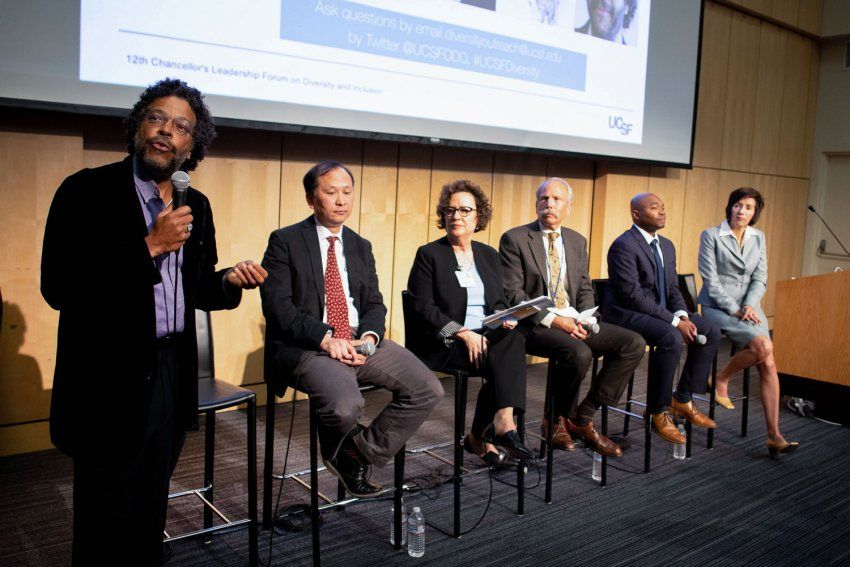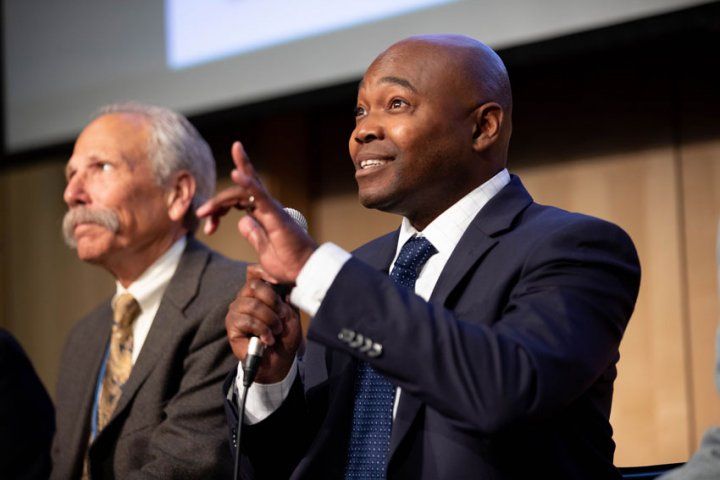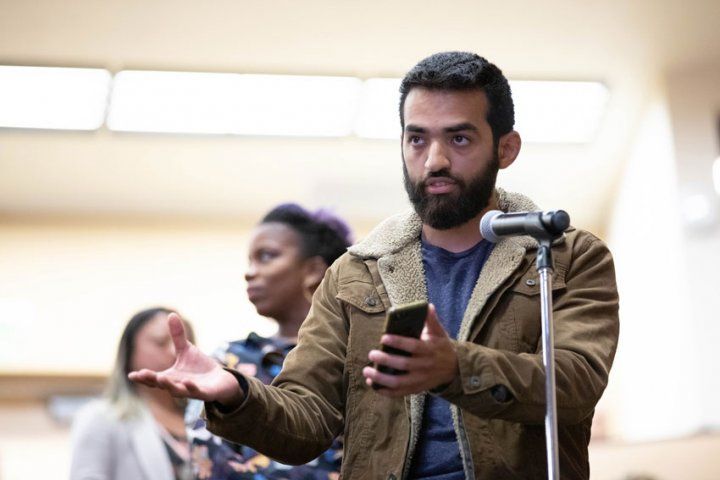12th Annual Chancellor's Diversity Forum Focuses on Fixing the Pipeline

The Chancellor's Leadership Forum on Diversity and Inclusion featured panelists (from left): Howard Pinderhughes, PhD; Tung Nguyen, MD; Cynthia Chiarappa, MBA, FACHE; Joseph Guglielmo, PhD; and Don Woodson, MEd; and moderator Lisa Cisneros. Photo by Susan Merrell
New and ongoing efforts to increase diversity among the UC San Francisco community were the focus of the 12th annual Chancellor’s Leadership Forum on Diversity & Inclusion.
The annual event is a platform for community members to hear from senior leadership on diversity initiatives across the University. This year’s forum took place in Cole Hall on April 25 and addressed the theme, “Outreach Efforts and the Leaky Pipeline for Students, Faculty and Staff.” After their talk, the panelists took questions from the audience and those submitted online.
“Our goal is to make UCSF representative of our city and of our state in which we live, and these efforts require continuous engagement by all of us,” said Chancellor Sam Hawgood, MBBS, in opening remarks. “It certainly cannot be achieved by sporadic interventions or by just a small select group of our community. It requires a sustained commitment to evaluate our recruitment and hiring practices as well as our climate to make UCSF a place where everyone can thrive.”
This year’s forum took place in Cole Hall on April 25 and addressed the theme, “Outreach Efforts and the Leaky Pipeline for Students, Faculty and Staff.”
Renee Navarro, MD, PharmD, vice chancellor of Diversity and Outreach, reviewed the latest demographics and some successes and challenges from the past year. Among students, trainees and faculty, the number of African-Americans increased just 1 percent from 2010 to 2018 (to 5 percent of students/trainees, and 3 percent of faculty), and the number of Hispanics increased 3 percent (to 11 percent of students/trainees, and 6 percent of faculty).
Among staff, 8 percent are African-American, 12 percent are Hispanic, and for the first time, Asians make up the largest group at 38 percent. However, the number of under-represented minorities in manager positions remains low. At the highest manager level, M4, there are no under-represented minorities and the majority are male despite a majority female staff overall.
Ongoing efforts to improve these numbers include implementing holistic admissions across professional and graduate schools, and training faculty equity advisers in best practices to recruit diverse candidates, she said.
Navarro also noted efforts to support LBGTQIA+ communities, including the Pronouns Matter campaign and renovations to the Office of Diversity and Outreach LGBT and Multicultural Resource Center.
Five panelists then highlighted diversity initiatives that addressed various points along the leaky pipeline.

Don Woodson, MEd, spoke about the Center for Science Education and Outreach. Photo by Susan Merrell
Over two decades, the Center for Science Education and Outreach has reached 16,000 students through its programs. “For the past 20 years, we have been working in the schools, helping students connect what we do here at UCSF to their dreams, to their hopes, to the possibility that one day they may be able to do something different,” said Don Woodson, MEd, the center’s director. In the last 12 years, 96 percent of participating students went on to higher education and 74 percent went directly to a four-year institution.
Addressing the steps beyond college, Joseph Guglielmo, PharmD, dean of the School of Pharmacy, talked about UCSF’s post-baccalaureate program aimed at disadvantaged and underrepresented communities. The one-year program prepares college graduates to become more competitive in applying to dental, medical, or pharmacy school. Guglielmo noted that cost was still a limitation – student debt from the program can range from $33,000 to $40,000 – and announced that the School of Pharmacy plans to cover half of the cost of the program.
Cynthia Chiarappa, MBA, FACHE, vice president of UCSF Health Administration, discussed improvements to recruitment practices, especially for senior positions such as the four currently open positions on the Chancellor’s senior leadership team. “In general, we heard, ‘It’s lonely at the top,’” she said. Best practices should include diverse search committees, training on implicit bias, diversity statements from candidates, and blinded applications that remove names and schools to create a level playing field, she said.

The annual forum is a platform for community members to hear from senior leadership on diversity initiatives across UCSF. Carlos Zuazo, a graduate student in the Biomedical Science program, asked a question during the forum. Photo by Susan Merrell
A lack of diversity cannot be attributed to pipeline issues alone, said Tung Nguyen, MD, professor of medicine. He urged for more creative solutions and investment in infrastructure. He highlighted the SF Build program, which mentors STEM students at San Francisco State University. “If you want URM (under-represented minority) people, you go to places where they are and find them,” he said. “San Francisco State has thousands of URM STEM students. So I don’t really want to hear the word pipeline when it comes to this – there are lots of people there, what are we doing to get them here?”
Howard Pinderhughes, PhD, professor and director of social and behavioral science in the School of Nursing, introduced a broader vision to leverage UCSF’s role as an anchor institution to help disadvantaged communities.
“Anchor institutions in a community have the capacity to create wealth and health in the surrounding community and they do it in a variety of ways,” he said. A new report on the anchor institution initiative, expected to be released this month, assesses how UCSF can use its economic power as the second largest employer in San Francisco to reduce health disparities and strategically move the needle on social determinants of health. “We have the potential to be a nationwide model, a gold standard for what an anchor institution should be,” he said.